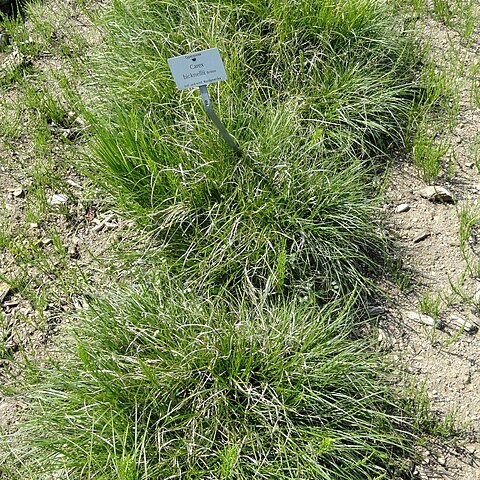Plants cespitose with fewer than 25 culms per clump; rhizomes appearing elongate only in old clumps. Culms (35–)40–110 cm; vegetative culms few, inconspicuous, with 6–8 leaves, not strikingly 3-ranked. Leaves: sheaths adaxially white-hyaline, summits concave or truncate, prolonged beyond collar to 2.5 mm, papillose at least near apex; distal ligules 1–5 mm; blades 3–4 per fertile culm, 2.5–25 cm × 2–5 mm, usually adaxially papillose. Inflorescences open, pale brown, 0.24–0.62 cm × 8–15 mm; proximal internode 5–17 mm; 2d internode 3–10 mm; proximal bracts scalelike, with bristle tips shorter than inflorescences. Spikes 3–6(–8), distant, distinct, ovoid to clavate, 7–21 × 5.5–12 mm, base rounded to long tapered, apex rounded. Pistillate scales reddish brown with green midstripe, lance-ovate to ovate, 3.1–5.4 mm, 1.9–3.2 times as long as wide, (1–)1.4–2.3 mm shorter than perigynia, narrower than perignyia, apex obtuse to acute. Anthers (2.4–)2.8–4.2 mm. Staminate scales obtuse. Perigynia 15–80 in larger spikes, ascending or ascending-spreading, green to pale whitish green with reddish brown margin, conspicuously 8–12-veined abaxially, 4–8-veined adaxially, broadly elliptic to nearly orbiculate, (4.5–)5.1–6.7(–7.1) × (2.4–)2.8–4.2 mm, 0.5–0.7 mm thick, membranaceous with brown achene visible through hyaline adaxial face, margin flat, including wing 0.8–1.2 mm wide, often erose, scalloped, or with an irregular tooth, smooth; beak pale brown at tip, flat, ciliate-serrulate, abaxial suture inconspicuous, distance from beak tip to achene 2.4–3.7 mm. Achenes elliptic to oblong, 1.6–2.2 × 1.1–1.6 mm, 0.5 mm thick. 2n = 76, 78.
More
In small tufts from a short, stout rhizome, aphyllopodic, 3–12 dm; main lvs 2–4 mm wide, shorter than the stem; sheaths ventrally hyaline; spikes 3–7, gynaecandrous, the pistillate part globose to ovoid, 8–12 mm, often clavate at base and to 18 mm including the staminate part, sessile, separate or somewhat aggregated into an oblong to linear cluster 3–7 cm; anthers 3–4 mm; pistillate scales lance-ovate, acute to acuminate, shorter (by 1–2 mm) and much narrower than the perigynia, pale brown with green midnerve and narrow hyaline margins; perigynia stramineous, broadly ovate, 4.2–7 (avg 5.7) mm, 1.3–2 times as long as wide, very flat, thin and almost translucent, broadly winged, sharply several-nerved on both sides, abruptly contracted to the flat, serrulate beak; achene lenticular, 1.6–2 × 1.5 mm; 2n=76. Open woods, fields, and meadows in moist or dry soil; Me. to Sask., s. to Del., O., Mo., Okla., and N.M.

